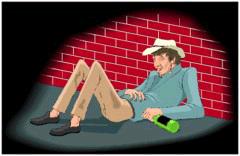|
Vol. 3, No. 6 |
Page 11 |
June, 2001 |
Beverage Alcohol
Alcohol in One's Diet
Often unrecognized, alcohol consumption has serious ramifications on the dietary intake. "One ounce of pure alcohol contains about 163 calories (or about 105 calories in a 1 1/2 ounce glass of whiskey or gin), but itdoes not contain vitamins or other physically beneficial nutrients." (Gail Gleason Milgram, Ed.D., “Facts On: The Effects of Alcohol,” Center of Alcohol Studies, Rutgers, The State University of New Jersey 1997, https://www.rci.rutgers.edu/~cas2/clearinghouse/factSheet/fact15.html. [14 Sep 1998])
The small amount of nutritive material in beer is more than offset by the alcohol content. Enough beer to furnish any significant amount of nutriment would contain enough alcohol to cause considerable damage to the body. (W.D. Jeffcoat, The Bible and "Social" Drinking, p. 83.)
The United States Department of Agriculture says that 100 grams of "table wine" (12.2 percent alcohol by volume) has 85 calories while 100 grams of "dessert wine" (18.8 percent alcohol by volume) has 135 calories. (Anonymous, Physiologic Notes On Wine, https://sbwines.silcom.com/usenet_winefaq/physiologic.html [21 Sep 1998])
Not only does alcohol not contribute to a healthy diet, the substitution of alcohol for any portion of one's ordinary food intake creates a substantial health risk.
Alcohol Induced Malnutrition
AB's [alcoholic beverages] contribute to malnutrition by replacing foods needed for essential nutrients and by interfering with absorption, storage or metabolism of the essential nutrients. Ethanol may suppress appetite and consumption of food. (Dr. Sidney Cohen, "Alcoholic Beverages and Alcohol Abuse," Environmed Research Inc., https://www.nutramed.com/ alcohol/alcohol.htm. [14 Sep 1998])
These risks include rapid water loss, electrolyte depletion, vitamin deficiency and toxicity to digestive organs.
There is rapid water loss (diuresis) within the first several hours of AB [alcoholic beverage] ingestion due to decreased secretion of antidiuretic hormone, a pituitary peptide. . . . Depletion of tissue magnesium (the serum magnesium level may not be reduced). Replacement of magnesium deficits is a recognized part of treatment of post-intoxication states. Hypocalcemia may also result from magnesium depletion by reducing parathyroid hormone-induced mobilization of calcium from bone. Reduced serum phosphate may lead to muscle weakness and degeneration. . . . Folate deficiency occurs in the majority of binge-drinking alcoholics and is a common cause of anemia. Inadequate dietary intake, intestinal malabsorption, and impaired folate storage in the liver all contribute to folate deficiency. Alcohol ingestion also interferes with vitamin B12 absorption. Deficiencies of the two vitamins cause large-cell (megaloblastic) anemia. Thiamine deficiency may occur in long-term alcohol users as a consequence of both inadequate ingestion and malabsorption of the vitamin. With severe deficiency, major brain disturbance or alcoholic psychosis emerges (Wernicke-Korsakoff syndrome). The brain dysfunction is global, with disordered thinking, feeling, remembering, and disturbed motor coordination. Thiamine replacement corrects the grosser dysfunctions of the brain and it has been proposed that alcoholic beverages be fortified with thiamine as a means of preventing this syndrome. Pyridoxine: (B6) metabolism is disturbed by the process of alcohol oxidation, contributing to anemia. Pellagra, or niacin deficiency, is common in chronic alcoholics. Pellagra is recognized by the three D's: Diarrhea, Dermatitis, and Dementia. Vitamin A storage is commonly decreased in alcohol-induced liver disease. With AB, protein-calorie malnutrition often occurs. Liver disease may lead to low blood protein and decreased serum levels of branched-chain amino acids. Micronutrients: Trace element metabolism may be disordered with regular AB input. Alcohol may increase the urinary loss of zinc and the gastrointestinal absorption of iron. Zinc deficiency aggravates vitamin A deficiency, since zinc is needed in the transformation of vitamin A into its active form. (Ibid.)
Too Much of a Good Thing?
The acclaimed health benefit of drinking alcohol goes down hill fast with successive drinks.
STROKE RISK One alcoholic drink a day may help prevent fatty deposits that lead to heart attack and stroke. But having more than four drinks a day raises the risk of stroke even more than heavy smoking does, say Italian and Austrian neurologists who studied 826 adults. (Jean Carper, "Eat Smart," USA Weekend, July 17-19, 1998, p. 12.)
Bad News for Beer & Wine Drinkers
Imbibers of beverage alcohol recently rejoiced at the news favoring alcohol as helpful in one's daily diet. Their spirits may be somewhat dampened, though, regarding some disclaimers accompanying those accounts.
CHOLESTEROL-CUTTING CHAMP Some scientists have wondered whether other alcohol can duplicate red wine's benefits. One answer: Red wine neutralizes the danger of bad LDL cholesterol better than white wine, beer or red grape juice, Japanese cardiologists have found. . . . Drinking white wine actually aggravated the danger. Beer and red grape juice had no effect. (Ibid.)
Conclusion
At best, the consumption of alcohol has little benefit to the human body. At worst, drinking alcohol reduces the efficiency of and harms one's body. Alcohol may also dull the appetite, resulting in withholding from one's body the much needed vitamins therein. Too much alcohol, over four glasses a day, poses a serious health risk. There are better and safer alternatives to promote good health beyond what alcohol may promise. Besides, after supposing themselves to have the medical industry's approval, social drinkers often meet or exceed amounts cited in disclaimers -- with little or no thought that they may be harming their bodies. Unfortunately, recent news about a health benefit attributed to alcohol doubtless will cause drinkers to imbibe with a false sense of security.
[Editor's Note: A book entitled Beverage Alcohol, written by the Editor is available for sale ($3.50 + S&H). This title is published in paperback format. Please contact us via email to purchase it.]


 Home
Home Current Issue
Current Issue Archives
Archives Bookstore
Bookstore Printshop
Printshop
 Plan of Salvation
Plan of Salvation Correspondence Course
Correspondence Course Daily Bible Reading
Daily Bible Reading
 Contact Us
Contact Us churches of Christ
churches of Christ Lauds
Lauds Links
Links

